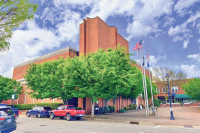Jackson should lift subdivision moratorium Aug. 6
Jackson County commissioners heard yet another round of public comment last week in the final countdown to passing the most restrictive slate of development regulations in the state.
The public hearing was billed as the final one on the issue, but after commissioners made a few minor changes to the ordinances — mostly changes in wording and phrasing — they decided to hold one more public hearing before passing them. It will be held Aug. 6 at 5:30 p.m. when commissioners have pledged to pass the regulations and lift the moratorium on new subdivision development.
The comments at the public hearing last week were largely more of the same. Critics believe the regulations are so over-the-top they will stymie development, hurt the construction and real estate driven economy and push up housing costs.
“It is easy to be cynical and wonder if the ordinances are meant to protect the environment and safety of mountain residents or just put a stop to all development — reading the ordinances leads me to believe the latter,” said Clark Lipkin, a surveyor opposed to the regulations.
Michael Moore compared his opposition to the ordinances with the fight for America’s freedom as a nation.
“Those who give up liberty for temporary security deserve neither liberty nor temporary security,” Moore said, quoting Ben Franklin.
Supporters believe the regulations will protect the mountain environment and the quality of life here, putting a needed check on development gone wild. Bill Kirwan commended the commissioners for their courage in proposing such regulations.
James McCarthy said public sentiment is in favor of the regulations and commissioners were wise to follow it.
“Everywhere you pick up a paper, they are talking about these same issues we are talking about right now. There is a change coming here now,” McCarthy said.
House colors
The only substantive change commissioners made to the regulations last week was eliminating the requirement for earth tone house colors on steep slopes. Commissioner William Shelton made the proposal. The ordinance originally read: “Exterior colors for new buildings and structures, including roofs, should be coordinated with the predominant colors of the surrounding landscape to minimize contrast between the structure and the natural environment. Exterior colors should be selected from among a color palette approved by the director.”
Shelton suggested that the use of earth tone colors should simply be a recommendation instead of a requirement, and that colors should not require approval. The other commissioners agreed.
Golf courses as open space
The other issue commissioners discussed, but ultimately did not change, was whether golf courses should count toward open space. New developments must set aside 25 percent of their acreage as open space. Developers are allowed to count golf courses toward that open space. But Shelton questioned whether that was in keeping with the spirit and intent of open space.
“I see a golf course as a beautiful thing, but in my eyes it is more of commercial enterprise and not necessarily a communal area,” Shelton said. Shelton said that golf courses are not environmentally friendly, requiring land clearing and earth moving to create the course and chemicals to maintain the greens.
Chairman Brian McMahan disagreed.
“Golf courses, whether viewed as a commercial standpoint or recreation standpoint, not only provide a source of recreation but I see golf courses as providing habitat, a nice open area for wildlife to graze and utilize. I think golf courses can provide a benefit,” said McMahan, who works for Balsam Mountain Preserve.
McMahan asked Shelton, a farmer, whether a garden — which also requires land clearing and use of fertilizer and pesticides — should count as open space.
“What if we had a developer that decided they wanted to have a communal garden, and come together and share in the vegetables or plant Christmas trees?” McMahan said.
“If you look at the acreages involved in a golf course, I think that is comparing apples and oranges when looking at a garden,” Shelton replied.
Commissioner Mark Jones, who works for High Hampton Inn, said golf courses can be beneficial if done well.
“Our facility has a lot of forest and vegetation up to the edge of the course,” Jones said of High Hampton. “They are there to make money — there is no question about it. But if done correctly, I feel they can provide a habitat for wildlife and groundwater recharge area.”
Commissioner Tom Massie said he philosophically sided with Shelton.
“There is a pretty strong smoking gun that there are problems with courses that over-fertilize and use too many pesticides,” Massie said. “Plus you don’t have access to it unless you pay the fees to go on their play yard.”
McMahan argued it was too late in the game to make a change like that now.
“In that case leave golf courses in for now, and a year from now when we revisit it, if golf courses have become problem, we can change it,” Massie said.
Commissioners plan to track problem areas in the ordinances — from loopholes to areas that are too strict — and fix those areas after seeing how the regulations play out.





